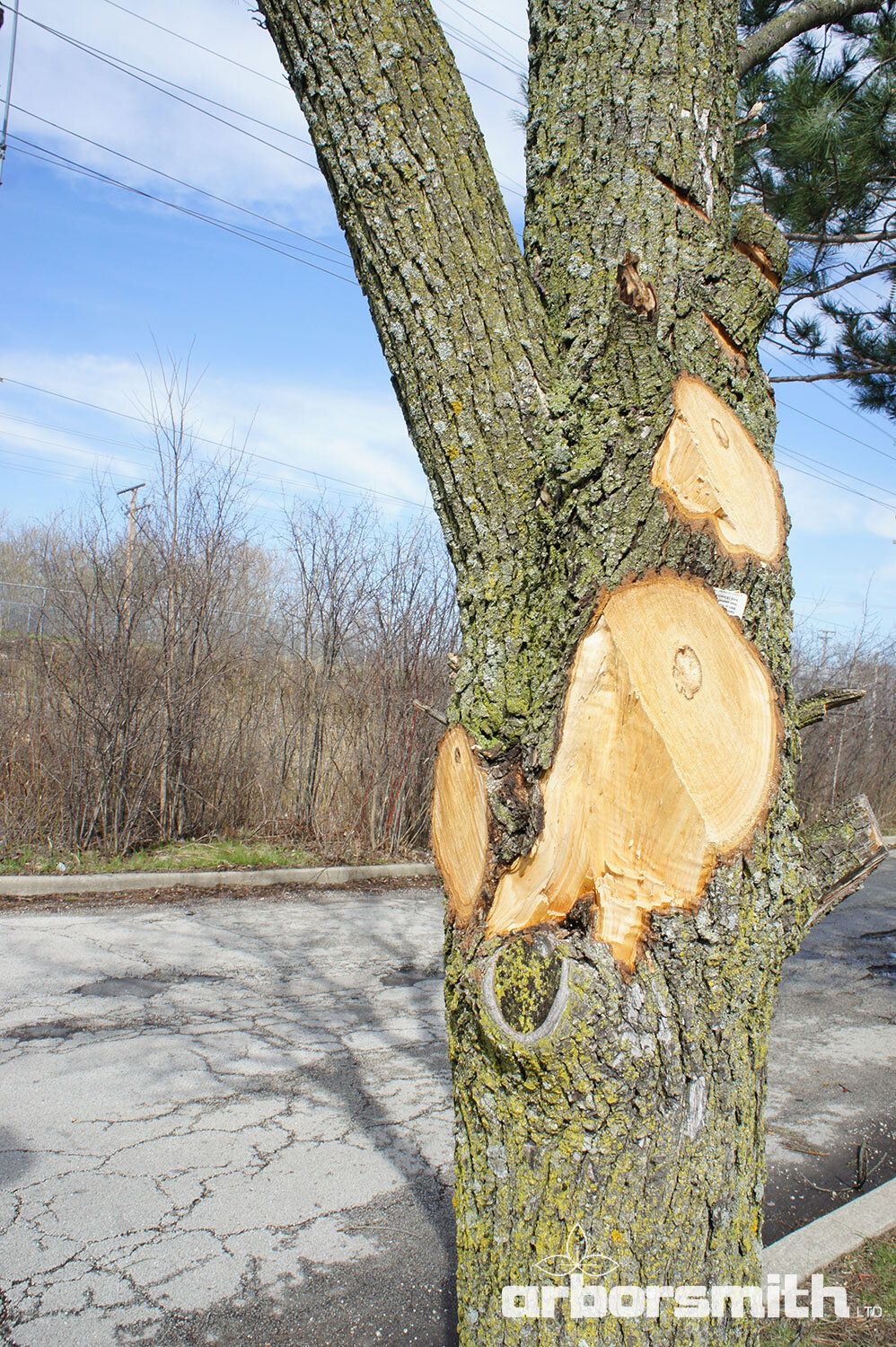Why Don’t Arborists Paint Cuts with Wound Dressing?
/The trimmers that made these cuts took a healthy tree and made it dangerous and weak.
by: Board Certified Master Arborist, Gilbert A Smith
Backyard Wisdom - April/May 2020
Most people would look at these cuts and think they were just fine. These cuts broke the barriers that prevent rot.
Fifty years ago when I was a young “tree skinner” Yes, that’s what they called us and with good reason. I was taught to paint all of the cuts that I made with tree tar. That was the measure of a good job. My father would say, “I saw a lot of ‘white eyes’ in the trees you trimmed today.” What an insult! “White eyes” were the newly exposed round tree cuts that looked like eyes on the branches. If my foreman saw too many of them, then I had to fill my leaky old paint pot, strap it to my tree saddle, climb back up the tree and paint every cut larger than 2 inches in diameter. One good reason we didn't trim on the way up, but always on the way down, was to avoid touching that sticky black tar from freshly painted cuts as we descended. We believed that paint prevented the tree from rotting. Besides my father and my foreman this was taught by the University of Illinois, the International Society of Arboriculture and the Morton Arboretum.
Forty years ago when I was attending the University of Illinois there was a great debate as to which type of paint was the most effective at stopping rot. So they did testing. Of course they had to have untreated wounds as a control group. Guess which type of paint created the least rot? To everyone’s surprise the untreated cut healed faster with less rot! Oh how the old timers screamed! “I’ve been doing this for 40 years and…. and well you paint the side of a barn to keep it from rotting don’t you?” The old timers had a good point so the US Forest Service and several universities did further testing to find out why unpainted wounds healed better.
The upshot was that trees have been around for a lot longer than we humans with our paint. Trees don't heal like we do, they do not replace damaged tissue with new tissue. Once a tree is wounded it is wounded for life. To prevent rot their strategy is:
To dry out so fungal rot can’t germinate as easily.
Limit nitrogen in their branch wood which makes it harder for microorganisms to degrade and consume them.
To change cellular structure. Any tree cells near the wound stop what they are doing, fill up with anti rotting resins and physical blocks, such as tyloses. In this way the tree forms 3 walls that inhibit rot.
When we painted the cuts the water was sealed into the wound but within 2 weeks the paint formed microscopic cracks just the right size for the spores of wood rotting fungi to find a happy, moist place to grow.
Further research by Dr. Alex Shigo at the US Forest Research Station revealed that cutting branches too close to the trunks (flush cuts) broke those defense walls that trees have put up to protect themselves. This allows rot to enter the trunks, weaken and make trees more dangerous. Oh how the old timers howled then!
So what did we learn about tree wounds?
The most important treatment to prevent rot is to know how to make a proper cut. The person who mows your lawn, or maybe your spouse, does not know how to make proper cuts. Their trimming can make your trees more dangerous and much less healthy.
Do not trim Oaks or American Elms in the summer or you risk attracting fatal Dutch Elm Disease or Oak Wilt. This is the exception to the painting rule: If you have storm damaged Oaks or Elms and you have to cut them in the summer it is mandatory that you paint the cuts to mask the pheromones released and avoid attracting the insects that carry those deadly diseases.
If the trimmer doesn't know how to identify trees then don't let them trim.One of the most damaging things you can do to your trees is to let people trim them with unsterile trimming tools. Fireblight is currently devastating Crab Apples, Apples, Hawthorns, Pears, Serviceberry, Cotoneaster, Mountain Ash, Roses, Quince and many other lovely ornamental plants because unknowledgeable landscapers spread Fireblight bacterium from tree to tree on their diseased infected tools.
You’ll be glad to know that I’m no longer a “tree skinner” but I’ve gone on to become an ISA Board Certified Master Arborist and these are a few things I’ve had to unlearn from the good old days.





